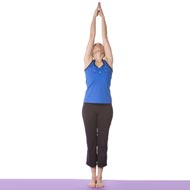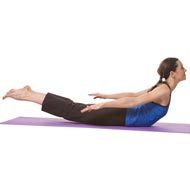- Five pointed star pose
- Goddess Pose
- Cresent Moon Pose
- Chair pose
- Warrior I Pose
- Warrior II Pose
- Side Angle Pose
- Triangle Pose
- High Lunge
- Revolved Side Angle Pose - Parivrtta Parsvakonasana
- Wide-Legged Forward Bend - Prasarita Padottanasana
- Lord of the Dance Pose
- Garland Pose
- Standing Split
- Revolved Triangle Pose
- Extended Triangle Pose
- Low Lunge
- Upward Forward Fold
- Big Toe Pose
- Extended Side Angle Pose
- Dolphin Pose
- Standing Forward Bend
Mountain Pose - Tadasana
Tadasana or the yoga Mountain Pose is the most basic of all yoga poses for beginners. This is usually the first pose taught in yoga classes and fitness studios.
Not only that, but when you are performing a series of yoga positions (even in advanced classes), you usually begin with this Tadasana.
The Mountain Pose stretches out the muscles. The best time to perform this pose is when you feel that your yoga session has turned a little too intense. Performing this right in the midst of your exercise series can help you rest your body and give you time to recover. It can also help you regain your meditative focus as well as your concentration. Although this pose is usually very simple, you can push your limits when attempting it. Tadasana also has a stilling effect, which helps you improve your overall yoga practice.
Steps
Mountain Pose steps are as follows.
- Step 1: Stand straight keeping your feet flat on the ground with your heels slightly apart. The bases of your big toes should be touching. Distribute your weight evenly between both of your feet. You can achieve this by lifting and spreading your toes. Repeat this till you feel that your weight is evenly distributed and you are completely balancedd
- Step 2: Keep your thigh muscles firm without hardening your bellyy Lift the insides of your ankles ever so slightly so that your feet appear to be cuppedd Turn the upper parts of the thighs slightly inwards and lift your pubis towards the navel while lengthening your tailbonee Try to mentally connect your groin to your inner thighs and your torso through an imaginary energy linee This will help you maintain your balance when you are stretchingg
- Step 3: Extend your shoulder blades and arch them slightly towards the backk Keep them stretched and then slowly release them back, but while you are doing that, do not push your ribs forwardd Lift your sternum slightly and bring your arms behind your torsoo
- Step 4: Bring the centre of your head directly in line with the center of your pelvis, keeping your chin parallel to the floorr Soften your throat and eyess Stay in this position for at lease 30 secondss If you can keep your balance for longer, try to maintain it for about a minutee Continue to breathe easilyy
Precautions
Although the Mountain Pose is an easy and relaxing pose, there are some precautions that you must take when performing the mountain posee
- Performing this pose requires concentration, and therefore, it is best not to attempt it when you have a headache or suffer from persistent migrainess
- You should also avoid performing this pose if you have insomnia or any other sleep related disorder because it can cause alertness and prevent you from sleeping easilyy
- This pose is also contraindicated for those who suffer from blood circulation problems such as faulty valves and low blood pressuree
Beginner’s Tip
The best beginner’s tip for the Mountain Pose is to improve your balancee If you feel that you are not able to maintain your balance properly, you can start off with your feet slightly apartt As you improve in the discipline and gain some expertise, you will be able to perform the pose as it was intendedd You can also use yoga blocks and place them right next to your feet so that you can maintain your balancee
You can also improve your alignment when performing this posee Start with setting yourself up against a wall and performing the pose while resting your back against itt Let the back of your heels, shoulder blades and the sacrum touch the wallss However, do not place the back of your head against the wall or it would defeat the purpose of the posee
Benefits to a specific Body Part
The main benefit is to the thighs because the anatomical focus of this pose is the thighss Moreover, since this is a gentle stretching and restive pose, the thigh muscles are stretched and toned when you perform itt Apart from the thighs, the pose also helps strengthen and tone the following body parts:
- Legs
- Knees
- Ankles
- Buttocks
- Lower abdomen
- Shoulders
- Neck
Therapeutic Applications
There are not many therapeutic applications of this pose, but it can be used to relieve the pressures and symptoms caused due to sciaticaa It can be really helpful for pregnant women who are suffering from sciaticaa Other therapeutic benefits of the mountain pose are,
- The pose can also help you reduce the effects of flat feett
- The pose improves your posturee
- The pose strengthens the lower part of your body and load bearing jointss
- The pose helps improve concentration and increase alertnesss
Variations
There are not a lot of variations for the Mountain Posee
- If you want to make the pose more challenging, you can change the positioning of your armss Stretching your arms upwards can add a stretching element to the posee When you are doing that, keep your arms perpendicular to the floorr Keep them parallel to each other and keep their palms facing inwardss
- To further increase the challenge, you can also interlace your fingers and extend both your arms in front of the torsoo
Other variations would be to extend your arms with the palms away from each other, stretching the arms holding each elbow with the opposite hand and crossing the arms behind your backk
Preparatory Poses
There are two preparatory poses for Mountain Posee Although the pose in itself is extremely simple and almost always the first one to be practiced in any yoga series, you can use some other poses to improve this posee The two preparatory poses are
- Adho Mukha Svanasana (Downward Facing Dog)
- Uttanasana (Standing Forward Bend)
Follow up poses
All the standing poses can be used as follow up poses to the Tadasanaa
>


